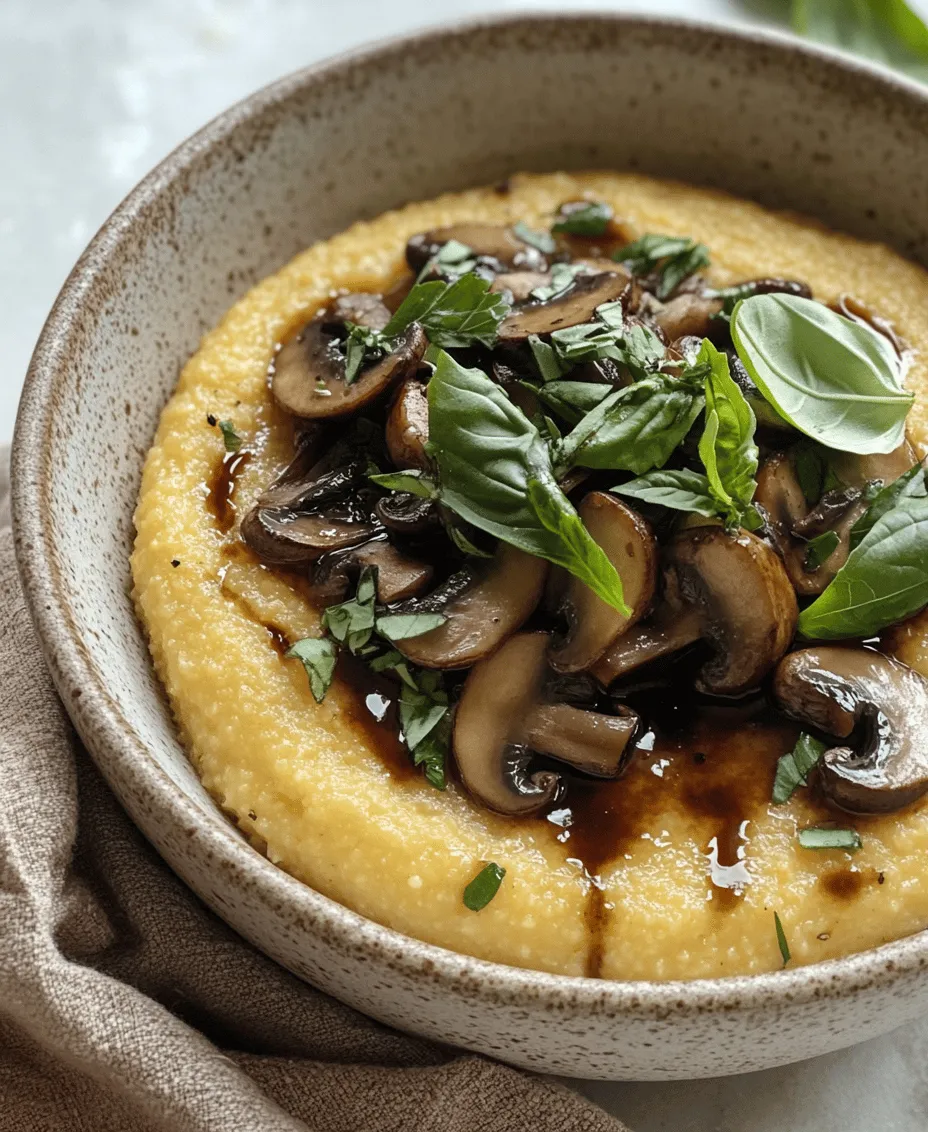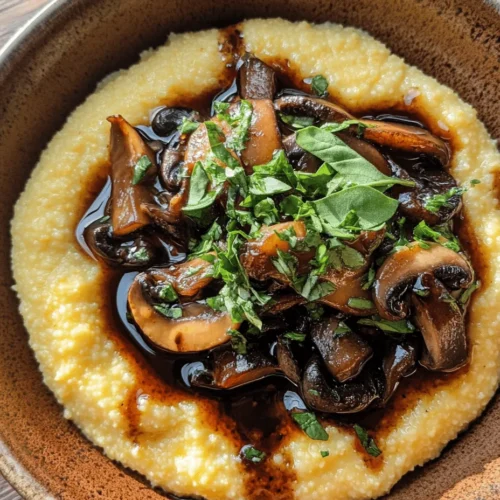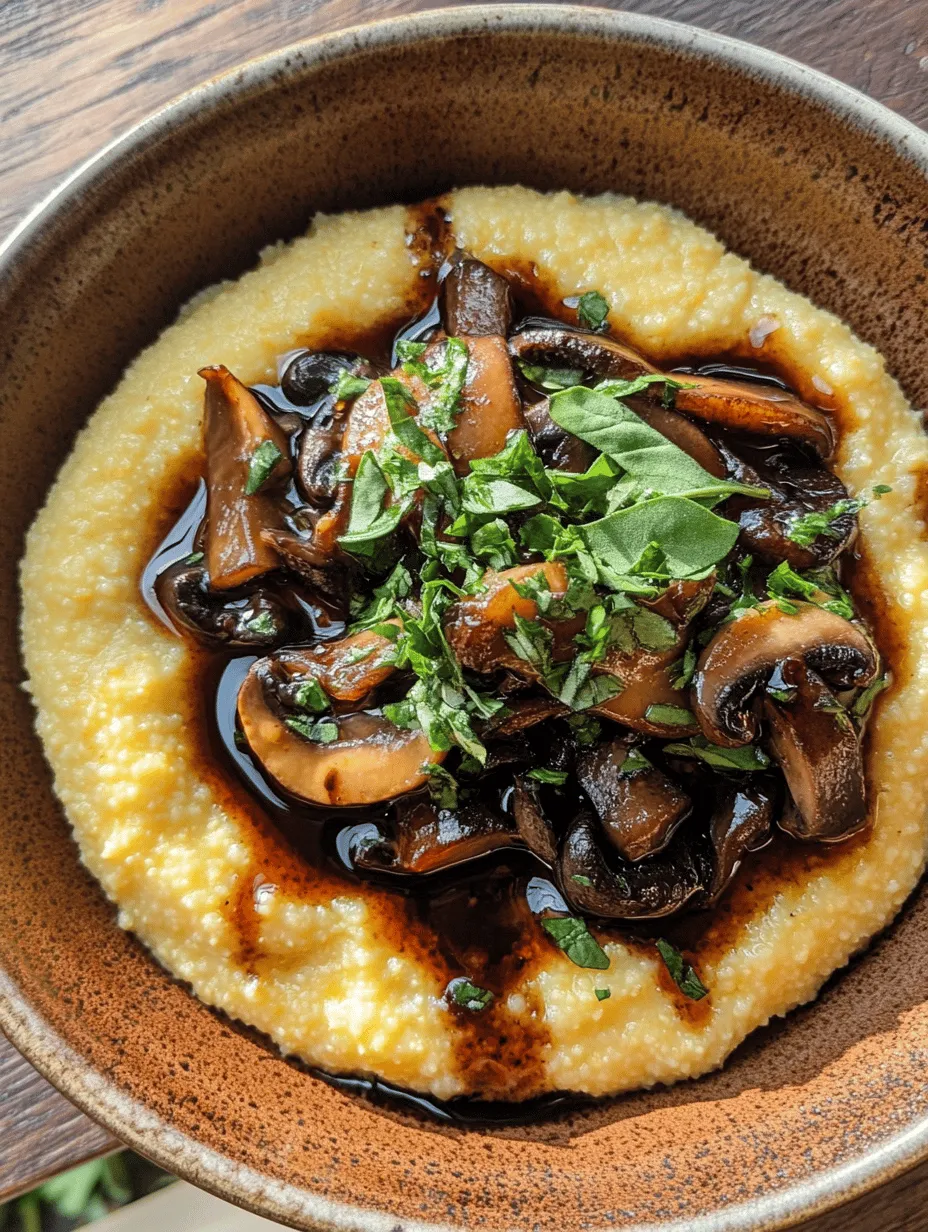Polenta is a dish that beautifully showcases the humble yet versatile nature of grains, turning them into a creamy delight that can be enjoyed in various ways. This Creamy Herb-Infused Polenta Delight recipe elevates the classic Italian staple, transforming it into a comforting meal that’s perfect for any occasion. Whether you’re hosting a dinner party, looking for a side dish to accompany your main course, or simply craving a nourishing bowl of comfort food, this recipe has got you covered. In this article, we will explore the origins of polenta, its nutritional benefits, and guide you through the steps to create this delicious dish.
Understanding Polenta: A Culinary Staple
Polenta has its roots in Northern Italy and dates back centuries, where it was traditionally made from ground cornmeal. This dish was a staple food for many Italian peasants, providing a hearty and filling option that could be served in various ways. Over time, polenta has gained popularity worldwide, finding its way into numerous cuisines and adapting to local tastes and ingredients.
Origins and Cultural Relevance
Polenta’s evolution from a peasant food to a gourmet dish illustrates its adaptability and appeal. In Italy, it is often served creamy, with the texture resembling that of mashed potatoes, or allowed to cool and set, then sliced and grilled or fried. Many cultures have their own variations of polenta, from the creamy, buttery versions in Italian cuisine to the firmer, sliceable forms found in South American dishes. This adaptability reflects polenta’s universal appeal and highlights its importance in various culinary traditions.
Nutritional Information and Health Benefits
One of the great benefits of polenta is its nutritional value. Made primarily from cornmeal, polenta is gluten-free, making it an excellent option for those with gluten sensitivities or celiac disease. Additionally, cornmeal is rich in carbohydrates, providing a solid source of energy, and is high in fiber, which promotes healthy digestion. Polenta also contains essential vitamins and minerals, including vitamin B6, magnesium, and phosphorus.
Common Misconceptions About Polenta
Despite its popularity, there are misconceptions about preparing polenta that can lead to frustration in the kitchen. Many people believe that polenta is complicated to make, but in reality, it is quite simple! The key is to use the right techniques and ingredients to achieve a creamy, lump-free texture. Additionally, some may assume that polenta must be served plain; however, this dish is incredibly versatile and can be flavored in countless ways, as we will explore in this recipe.
Gathering Ingredients for Polenta Perfection
To achieve the best results for your Creamy Herb-Infused Polenta Delight, gathering the right ingredients is crucial. Below is a detailed overview of the key components that will make this dish stand out.
Cornmeal: Types and What to Choose
The first step in making polenta is selecting the right type of cornmeal. Polenta can be made from different varieties of cornmeal, including coarse, medium, or fine ground. For this recipe, we recommend using medium ground cornmeal for the perfect texture. It strikes a balance between creaminess and structure, allowing the polenta to be both soft and sliceable once cooled.
The Role of Liquids: Water vs. Vegetable Broth
The liquid used to cook the polenta significantly impacts its flavor and richness. While water can be used, opting for vegetable broth will infuse the polenta with additional depth and savoriness. Homemade or store-bought broth can elevate the overall taste, making your polenta even more delicious.
Dairy Choices: Whole Milk and Alternatives
Dairy plays a crucial role in the creaminess of polenta. Whole milk is often used for its rich flavor and texture, but there are plenty of alternatives for those who prefer a dairy-free option. Unsweetened almond milk, coconut milk, or even cashew milk can be substituted to achieve a creamy consistency without compromising on taste.
Fresh Herbs: Importance of Basil and Parsley
Fresh herbs are essential in enhancing the flavor profile of your polenta. In this recipe, basil and parsley are used to infuse the dish with brightness and freshness. Using fresh herbs over dried ones will create a more vibrant and aromatic result, making every bite a delightful experience. Prioritize high-quality, fresh herbs for the best outcome.
Optional Toppings: Ideas for Customizing Your Dish
One of the beautiful aspects of polenta is its versatility. While this recipe focuses on a creamy herb-infused base, consider adding toppings to customize your dish further. Grated Parmesan cheese, sautéed mushrooms, roasted vegetables, or a drizzle of olive oil can enhance the flavors and add an extra layer of texture. Feel free to experiment with your favorite toppings to make the dish your own.
Step-by-Step Guide to Making Creamy Herb-Infused Polenta
Now that you have all the necessary ingredients, it’s time to dive into the cooking process. Follow this comprehensive guide to make your Creamy Herb-Infused Polenta Delight, ensuring that each step is clear and straightforward.
Preparing the Base: Boiling the Liquid and Adding Seasonings
1. Start by preparing your liquid: In a large saucepan, combine 4 cups of vegetable broth (or water) with a pinch of salt. Bring this mixture to a boil over medium-high heat. The salt is crucial as it adds flavor to the polenta from the start.
2. Infuse the broth: As the broth heats, consider adding a couple of garlic cloves or a sprig of the fresh herbs to infuse additional flavor. This step is optional, but it can create a more fragrant base for your polenta.
Incorporating the Cornmeal: Techniques for a Lump-Free Texture
3. Whisk in the cornmeal: Once the broth is boiling, reduce the heat to low. Gradually whisk in 1 cup of medium ground cornmeal. This slow incorporation is essential to prevent lumps from forming. Whisk continuously for about 1-2 minutes until the cornmeal is fully integrated into the liquid.
4. Cook the polenta: Continue to cook the mixture over low heat, stirring frequently with a wooden spoon or spatula. This step is crucial, as it allows the polenta to absorb the liquid and thicken properly. Expect to cook the polenta for about 20-30 minutes, depending on the coarseness of your cornmeal. The polenta is done when it pulls away from the sides of the pan and has a creamy consistency.
5. Add dairy and herbs: Once the polenta reaches the desired texture, remove it from the heat. Stir in 1 cup of whole milk (or your chosen dairy alternative) until fully incorporated. Then, fold in the chopped fresh basil and parsley, adjusting the quantity to your taste. This step infuses the polenta with vibrant herb flavors, making it a standout dish.
As you continue this culinary adventure, remember that the key to a successful polenta lies in patience and attention to detail. Each step is designed to enhance the flavors and textures, resulting in a creamy, herb-infused delight that will impress your family and friends. In the next section, we will delve into additional cooking tips and presentation ideas to elevate your dining experience even further.

Achieving the Perfect Consistency: Tips for Cooking Times and Stirring
When it comes to preparing creamy herb-infused polenta, achieving the perfect consistency is crucial. The beauty of polenta lies in its texture—smooth and creamy, yet firm enough to hold its shape. To get there, begin by bringing your water or broth to a gentle boil. Once boiling, gradually whisk in the cornmeal. This gradual incorporation is essential; it prevents lumps from forming and ensures a silky texture.
Stir continuously for the first few minutes to help the cornmeal absorb the liquid properly. After that initial stirring, reduce the heat to low. The polenta will need to simmer gently, allowing the cornmeal to soften and thicken. Typically, cooking times range from 30 to 45 minutes. It’s important to stir frequently—every 5 to 10 minutes—ensuring that the polenta doesn’t stick to the bottom of the pot and burn. If it becomes too thick, add more broth or water a few tablespoons at a time until you reach your desired creaminess.
Enriching the Polenta: Adding Butter, Cheese, and Fresh Herbs
To elevate the flavor of your polenta, enrich it with butter, cheese, and fresh herbs at the end of the cooking process. Once your polenta has thickened to your liking, remove it from the heat and stir in a generous amount of unsalted butter. This will not only add richness but also enhance the creamy texture.
For a cheesy twist, incorporate freshly grated Parmesan or Pecorino cheese, allowing it to melt into the warm polenta. This addition brings a savory depth that complements the dish beautifully. Don’t forget to fold in your freshly chopped herbs—basil and parsley work wonderfully in this recipe. Their vibrant flavors will infuse the polenta, giving it a fresh and aromatic finish. Adjust the seasoning with salt and pepper to taste, ensuring that every bite is full of flavor.
Serving Suggestions: Elevating Your Polenta Dish
Polenta is versatile and can be served in numerous creative ways. To make your dish visually appealing and delicious, consider these serving suggestions:
Suggested Toppings: Sautéed Mushrooms, Roasted Vegetables, and Their Flavor Profiles
One of the simplest ways to enhance your creamy herb-infused polenta is by adding toppings. Sautéed mushrooms, especially varieties like shiitake or cremini, provide an earthy flavor that pairs beautifully with the creaminess of the polenta. Just sauté them in olive oil with a pinch of garlic until golden brown, and spoon them generously over the polenta.
Roasted vegetables are another fantastic option. Think of a medley of bell peppers, zucchini, carrots, and Brussels sprouts, seasoned with herbs and olive oil, then roasted until caramelized. These add not only color but also a delightful sweetness and texture contrast to the dish.
Sauces and Glazes: The Impact of Balsamic Glaze on Taste
To further elevate your polenta, consider drizzling a balsamic glaze over the top. This sweet yet tangy sauce adds a burst of flavor that balances the richness of the polenta. The acidity of the balsamic cuts through the creaminess, providing a perfect finish. Simply reduce balsamic vinegar over low heat until it thickens, or purchase a pre-made glaze for convenience.
Plating Ideas: How to Present Polenta for a Beautiful Meal
Presentation is key when serving polenta. To create an elegant dish, consider using a ring mold to shape your polenta into a neat round. Top with your sautéed mushrooms or roasted vegetables, followed by a drizzle of balsamic glaze. Garnish with additional fresh herbs for a pop of color. Serving polenta in individual bowls with toppings artfully arranged can also create a cozy, inviting feel.
Nutritional Benefits of the Ingredients
Understanding the health benefits of the ingredients used in creamy herb-infused polenta can enhance your appreciation of this dish:
The Nutritional Profile of Cornmeal and Its Role in a Balanced Diet
Cornmeal is the star ingredient in polenta and offers several nutritional benefits. It is a good source of carbohydrates, providing energy for your daily activities. Cornmeal is also rich in fiber, which aids digestion and helps maintain a healthy gut. Additionally, it contains essential vitamins and minerals, including selenium and B vitamins, which support overall health.
Benefits of Fresh Herbs: Basil and Parsley’s Contributions to Health
Fresh herbs like basil and parsley not only enhance the flavor of your polenta but also contribute to your health. Basil is known for its anti-inflammatory properties and is rich in antioxidants. It may also support heart health and aid digestion. Parsley, on the other hand, is packed with vitamins A, C, and K, and is known for its detoxifying properties. Including these herbs in your polenta is a delicious way to boost its nutritional profile.
The Importance of Healthy Fats: Butter and Olive Oil in Moderation
While butter and olive oil add richness and flavor to your polenta, they also provide healthy fats that are important for your body. Olive oil is known for its heart-healthy monounsaturated fats and antioxidants, which can reduce inflammation. Butter, when used in moderation, can contribute to a satisfying texture and flavor, along with fat-soluble vitamins like A and E. Balancing these healthy fats in your diet can support overall well-being.
Exploring Variations of Creamy Herb-Infused Polenta
Encouraging creativity in the kitchen can lead to delightful variations of creamy herb-infused polenta. Here are some ideas to inspire your culinary adventures:
Gluten-Free Options: Substituting Cornmeal
For those who are gluten-sensitive or seeking gluten-free options, cornmeal is a natural choice. However, if you’re looking to experiment, consider using polenta made from other grains like quinoa or rice flour. These alternatives can offer unique flavors and textures while maintaining the creamy consistency that makes this dish so comforting.
Vegan Adaptations: Replacing Dairy and Using Plant-Based Ingredients
To make a vegan version of creamy herb-infused polenta, simply replace butter with plant-based alternatives like vegan butter or coconut oil. For the cheese, nutritional yeast can provide a cheesy flavor without the dairy. Additionally, using vegetable broth instead of chicken broth will keep it entirely plant-based while enriching the flavor.
Flavor Variations: Adding Spices and Other Herbs for a Twist
Don’t be afraid to experiment with flavors! Try adding spices such as smoked paprika or cumin to the cooking water for a smoky kick. Alternatively, infuse the polenta with garlic powder or onion powder for an extra layer of flavor. You can also switch up the herbs—rosemary and thyme can provide a more aromatic and earthy taste, while cilantro or dill can add a fresh twist.
Conclusion: Embracing the Comfort of Creamy Herb-Infused Polenta
Making creamy herb-infused polenta is not just about creating a dish; it’s about embracing the comforting nature of homemade food. Whether served as a side to a hearty main course or enjoyed on its own, this polenta dish is a wonderful canvas for your culinary creativity. The process of cooking and savoring polenta can be both rewarding and relaxing, bringing a sense of warmth to your kitchen.
As you explore the various serving suggestions, nutritional benefits, and creative variations, remember that cooking is an art that allows for personal expression. Don’t hesitate to make this recipe your own, infusing it with flavors and ingredients you love. Whether it’s a cozy family dinner or an elegant gathering with friends, creamy herb-infused polenta is sure to impress and satisfy. So roll up your sleeves, get cooking, and enjoy every delicious bite of this delightful dish.



